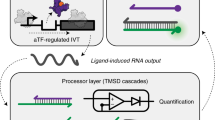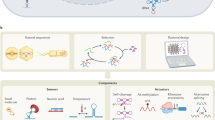Abstract
DNA strand displacement has been widely used for the design of molecular circuits, motors, and sensors in cell-free settings. Recently, it has been shown that this technology can also operate in biological environments, but capabilities remain limited. Here, we look to adapt strand displacement and exchange reactions to mammalian cells and report DNA circuitry that can directly interact with a native mRNA. We began by optimizing the cellular performance of fluorescent reporters based on four-way strand exchange reactions and identified robust design principles by systematically varying the molecular structure, chemistry and delivery method. Next, we developed and tested AND and OR logic gates based on four-way strand exchange, demonstrating the feasibility of multi-input logic. Finally, we established that functional siRNA could be activated through strand exchange, and used native mRNA as programmable scaffolds for co-localizing gates and visualizing their operation with subcellular resolution.
This is a preview of subscription content, access via your institution
Access options
Subscribe to this journal
Receive 12 print issues and online access
$259.00 per year
only $21.58 per issue
Buy this article
- Purchase on Springer Link
- Instant access to full article PDF
Prices may be subject to local taxes which are calculated during checkout






Similar content being viewed by others
References
Zhang, D. Y. & Seelig, G. Dynamic DNA nanotechnology using strand-displacement reactions. Nature Chem. 3, 103–113 (2011).
Qian, L. & Winfree, E. Scaling up digital circuit computation with DNA strand displacement cascades. Science 332, 1196–1201 (2011).
Seelig, G., Soloveichik, D., Zhang, D. Y. & Winfree, E. Enzyme-free nucleic acid logic circuits. Science 314, 1585–1588 (2006).
Benenson, Y., Gil, B., Ben-Dor, U., Adar, R. & Shapiro, E. An autonomous molecular computer for logical control of gene expression. Nature 429, 423–429 (2004).
Elbaz, J. et al. DNA computing circuits using libraries of DNAzyme subunits. Nature Nanotech. 5, 417–422 (2010).
Benenson, Y. et al. Programmable and autonomous computing machine made of biomolecules. Nature 414, 430–434 (2001).
Chen, Y.-J. et al. Programmable chemical controllers made from DNA. Nature Nanotech. 8, 755–762 (2013).
Soloveichik, D., Seelig, G. & Winfree, E. DNA as a universal substrate for chemical kinetics. Proc. Natl Acad. Sci. USA 107, 5393–5398 (2010).
Oishi, K. & Klavins, E. Biomolecular implementation of linear I/O systems. IET Syst. Biol. 5, 252–260 (2011).
Qian, L., Winfree, E. & Bruck, J. Neural network computation with DNA strand displacement cascades. Nature 475, 368–372 (2011).
Dirks, R. M. & Pierce, N. A. Triggered amplification by hybridization chain reaction. Proc. Natl Acad. Sci. USA 101, 15275–15278 (2004).
Yin, P., Choi, H. M. T., Calvert, C. R. & Pierce, N. A. Programming biomolecular self-assembly pathways. Nature 451, 318–322 (2008).
Zhang, D. Y., Turberfield, A. J., Yurke, B. & Winfree, E. Engineering entropy-driven reactions and networks catalyzed by DNA. Science 318, 1121–1125 (2007).
Seelig, G., Yurke, B. & Winfree, E. Catalyzed relaxation of a metastable DNA fuel. J. Am. Chem. Soc. 128, 12211–12220 (2006).
Turberfield, A. J. et al. DNA fuel for free-running nanomachines. Phys. Rev. Lett. 90, 118102 (2003).
Venkataraman, S., Dirks, R. M., Rothemund, P. W., Winfree, E. & Pierce, N. A. An autonomous polymerization motor powered by DNA hybridization. Nature Nanotech. 2, 490–494 (2007).
Omabegho, T., Sha, R. & Seeman, N. C. A bipedal DNA Brownian motor with coordinated legs. Science 324, 67–71 (2009).
Green, S., Bath, J. & Turberfield, A. J. Coordinated chemomechanical cycles: a mechanism for autonomous molecular motion. Phys. Rev. Lett. 101, 238101 (2008).
Andersen, E. S. et al. Self-assembly of a nanoscale DNA box with a controllable lid. Nature 459, 73–76 (2009).
Yurke, B., Turberfield, A. J., Mills, A. P. Jr., Simmel, F. C. & Neumann, J. L. A DNA-fuelled molecular machine made of DNA. Nature 406, 605–608 (2000).
Green, S. J., Lubrich, D. & Turberfield, A. J. DNA hairpins: fuel for autonomous DNA devices. Biophys. J. 91, 2966–2975 (2006).
Zhang, D. Y., Hariadi, R. F., Choi, H. M. T. & Winfree, E. Integrating DNA strand-displacement circuitry with DNA tile self-assembly. Nature Commun. 4, 1965 (2013).
Chen, Y.-J., Groves, B., Muscat, R. A. & Seelig, G. DNA nanotechnology from the test tube to the cell. Nature Nanotech. 10, 748–760 (2015).
Choi, H. M. T. et al. Programmable in situ amplification for multiplexed imaging of mRNA expression. Nature Biotech. 28, 1208–1212 (2010).
Duose, D. Y. et al. Configuring robust DNA strand displacement reactions for in situ molecular analyses. Nucleic Acids Res. 40, 3289–3298 (2012).
Douglas, S. M., Bachelet, I. & Church, G. M. A logic-gated nanorobot for targeted transport of molecular payloads. Science 335, 831–834 (2012).
Amir, Y. et al. Universal computing by DNA origami robots in a living animal. Nature Nanotech. 9, 353–357 (2014).
Rudchenko, M. et al. Autonomous molecular cascades for evaluation of cell surfaces. Nature Nanotech. 8, 580–586 (2013).
Jiang, Q. et al. DNA origami as a carrier for circumvention of drug resistance. J. Am. Chem. Soc. 134, 13396–13403 (2012).
Schüller, V. J. et al. Cellular immunostimulation by CpG-sequence-coated DNA origami structures. ACS Nano 5, 9696–9702 (2011).
Modi, S., Nizak, C., Surana, S., Halder, S. & Krishnan, Y. Two DNA nanomachines map pH changes along intersecting endocytic pathways inside the same cell. Nature Nanotech. 8, 459–467 (2013).
Kahan-Hanum, M., Douek, Y., Adar, R. & Shapiro, E. A library of programmable DNAzymes that operate in a cellular environment. Sci. Rep. 3, 1535 (2013).
Delebecque, C. J., Lindner, A. B., Silver, P. A. & Aldaye, F. A. Organization of intracellular reactions with rationally designed RNA assemblies. Science 333, 470–474 (2011).
Hemphill, J. & Deiters, A. DNA computation in mammalian cells: microRNA logic operations. J. Am. Chem. Soc. 135, 10512–10518 (2013).
Chen, S. X., Zhang, D. Y. & Seelig, G. Conditionally fluorescent molecular probes for detecting single base changes in double-stranded DNA. Nature Chem. 5, 782–789 (2013).
Radding, C. M., Beattie, K. L., Holloman, W. K. & Wiegand, R. C. Uptake of homologous single-stranded fragments by superhelical DNA. J. Mol. Biol. 116, 805–824 (1977).
Thompson, B. J., Camien, M. N. & Warner, R. C. Kinetics of branch migration in double-stranded DNA. Proc. Natl Acad. Sci. USA 73, 2299–2303 (1976).
Zhang, D. Y. & Winfree, E. Control of DNA strand displacement kinetics using toehold exchange. J. Am. Chem. Soc. 131, 17303–17314 (2009).
Santangelo, P. J. Molecular beacons and related probes for intracellular RNA imaging. WIREs. Nanomedic. Nanobiotech. 2, 11–19 (2010).
Bramsen, J. B. et al. A large-scale chemical modification screen identifies design rules to generate siRNAs with high activity, high stability and low toxicity. Nucleic Acids Res. 37, 2867–2881 (2009).
Amarzguioui, M., Holen, T., Babaie, E. & Prydz, H. Tolerance for mutations and chemical modifications in a siRNA. Nucleic Acids Res. 31, 589–595 (2003).
Afonin, K. A. et al. Activation of different split functionalities on re-association of RNA-DNA hybrids. Nature Nanotech. 8, 296–304 (2013).
Dias, N. & Stein, C. A. Antisense oligonucleotides: basic concepts and mechanisms. Mol. Cancer Ther. 1, 347–355 (2002).
Harborth, J. et al. Sequence, chemical, and structural variation of small interfering RNAs and short hairpin RNAs and the effect on mammalian gene silencing. Antisense Nucleic Acid Drug Dev. 13, 83–105 (2003).
Tyagi, S. Imaging intracellular RNA distribution and dynamics in living cells. Nature Methods 6, 331–338 (2009).
Lennox, K. et al. Characterization of modified antisense oligonucleotides in Xenopus laevis embryos. Oligonucleotides 16, 26–42 (2006).
Czauderna, F. et al. Structural variations and stabilising modifications of synthetic siRNAs in mammalian cells. Nucleic Acids Res. 31, 2705–2716 (2003).
Santangelo, P. J. et al. Single molecule–sensitive probes for imaging RNA in live cells. Nature Methods 6, 10–14 (2009).
Sivaraman, D., Biswas, P., Cella, L. N., Yates, M. V. & Chen, W. Detecting RNA viruses in living mammalian cells by fluorescence microscopy. Trends Biotechnol. 29, 307–313 (2011).
Lifland, A. W., Zurla, C., Yu, J. & Santangelo, P. J. Dynamics of native β-actin mRNA transport in the cytoplasm. Traffic 12, 1000–1011 (2011).
Acknowledgements
We thank D. Soloveichik, E. Winfree, and D. Y. Zhang for their help in designing the logic AND gate. This material is based on work supported by the Defense Advanced Research Projects Agency (DARPA) under Contract No. W911NF-11-2-0068 to G.S. and P.J.S. Additional support was provided by NSF CAREER Award No. 1253691 (P.J.S.), regarding RNA imaging, and NIH GM094198 (P.J.S.), for the use of hRSV cell models during development.
Author information
Authors and Affiliations
Contributions
P.J.S. and G.S. conceived the project, B.G., Y.-J.C., C.Z., S.P., P.J.S. and G.S. designed experiments, B.G., Y.-J.C., C.Z., and S.P. performed the experiments, J.L.K. and P.S. developed the monovalent MTRIPs, B.G., Y.-J.C., C.Z., analysed the data, B.G. Y.-J. C., C.Z., P.J.S, and G.S. wrote the paper.
Corresponding authors
Ethics declarations
Competing interests
The authors declare no competing financial interests.
Supplementary information
Supplementary information
Supplementary information (PDF 7969 kb)
Rights and permissions
About this article
Cite this article
Groves, B., Chen, YJ., Zurla, C. et al. Computing in mammalian cells with nucleic acid strand exchange. Nature Nanotech 11, 287–294 (2016). https://doi.org/10.1038/nnano.2015.278
Received:
Accepted:
Published:
Issue Date:
DOI: https://doi.org/10.1038/nnano.2015.278
This article is cited by
-
A temporally resolved DNA framework state machine in living cells
Nature Machine Intelligence (2023)
-
Modular, programmable RNA sensing using ADAR editing in living cells
Nature Biotechnology (2023)
-
General-purpose DNA computation
Science China Chemistry (2023)
-
A spatially-controlled DNA triangular prism nanomachine for AND-gated intracellular imaging of ATP in acidic microenvironment
Microchimica Acta (2023)
-
Standardized excitable elements for scalable engineering of far-from-equilibrium chemical networks
Nature Chemistry (2022)



